This post may contain affiliate links. If you use these links to buy something we may earn a commission. Thanks.
Sick of looking at empty or lackluster shade? A fast-growing ground cover fills in those empty spots within a few short months of the season. Better yet, a shade-loving ground cover will remain lush for its long life in minimal light settings.
In this post, you’ll find the best shade-loving ground covers with fast-spreading habits, and with little effort, they’ll look great.
Shade tends to be a tough spot for many popular ground covers to thrive as many require full sun positions. Inappropriate plant choices lead to straggly-looking messes. This problem can finally be solved as you’ll only find shade-lovers in this article.
Related: 15 Easiest Ground Covers that Thrive in Shade

Be aware that fast-growing plants (that specifically thrive in shade) are among the most likely to be invasive. Not all, however, may be invasive in your area.
So simply scan the details of each ground cover below, narrow your list with the ones that will do well in the spot you have in mind, and then determine which aren’t considered invasive in your area. From there, buy plants or seeds where you can and get planting!
See: USDA list of invasive species by area
Jerusalem Sage/Lungwort (Pulmonaria saccharata)
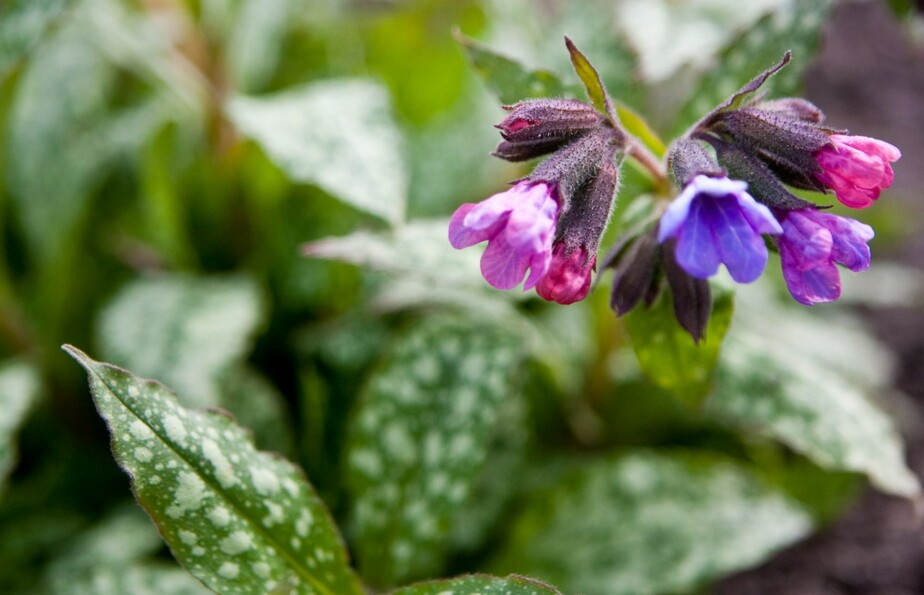
Fun fact, if you have a walnut that nothing grows under, plant lungwort! They thrive in all light conditions from full to partial shade and aren’t affected by the anti-plant chemical that black walnut trees produce.
Lungwort thrives in the understories of trees and other shaded areas. In these proper conditions, they tend to spread fast and are resistant to deer. Their foliage is quite beautiful and these plants are long-lived.
Lungwort is not generally known for being invasive.
- Height: 12-18 inches
- Range: Europe
- Climate: Zones 4-8
- Functions: Accompanied by purple flowers, the spotted semi-evergreen leaves are rough with coarse hairs. Deer and rabbits tend to avoid the plant for its texture. This ground cover is best used as a pest-deterring ornamental.
- Light requirements: Full/deep shade to partial shade or full sun.
- Soil preferences: Moist soil is ideal but tolerates drought.
Nature Hills Nursery currently offers 4 types of lungwort.
Great Yellow Woodsorrel (Oxalis grandis)

Also known as great yellow wood sorrel. Sorrel has a lemony flavor and is often added to salads.
This is a perfect ground cover for poor soil settings as it will grow fast regardless of soil quality. This plant, however, is considered invasive in Kentucky and is generally regarded as a weed in the rest of the US. A weed is a plant you don’t want. so if you want it, it isn’t a weed.
Invasive, on the other hand, doesn’t always mean ‘bad.’ Some invasive plants (like garlic mustard) are to the point where they release toxic chemicals into the soil to kill and overtake surrounding plants. This sorrel is simply a fast grower that happens to be edible and sometimes not considered a weed among those who eat from their gardens.
- Height: 8 inches
- Range: Native to North America
- Climate: Zones 5-7
- Functions: Edible addition to polycultures in native, woodland, or food forest gardens.
- Light requirements: Full to partial shade.
- Soil preferences: Moist-dry soil and suitable for heavy clay.
While tough to find this specific variety for sale online, you may find someone local who offers seeds or roots. Various other types of edible and shade-loving sorrel are offered here.
Green and gold (Chrysogonum virginianum)

Often used as an alternative to creeping jenny or winter creeper as it’s a beautiful native plant that grows just as fast.
An easy-going and low-maintenance native ground cover with soft-petalled and nectar-filled flowers. This is a very popular ground cover as it fulfills ornamental value and wildlife preservation. Songbirds, bees, and butterflies love it!
- Height: 6-12 inches
- Range: Native to North America
- Climate: Zones 5-9
- Functions: Quick ground coverage. Pollinator or native gardens.
- Light requirements: Full, partial, or no shade.
- Soil preferences: Moist or dry soil with good drainage.
Also known as ‘golden star’ you’ll find it available here.
Lily of the Valley (Convallaria majalis)
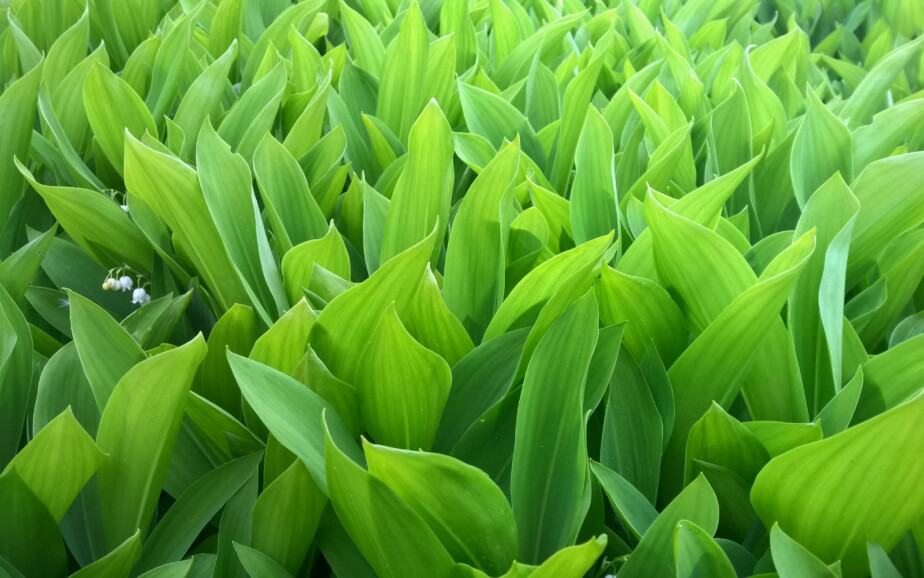
Lily of the valley is a very popular ornamental ground cover as it spreads fast and smells pleasant. It’s also a common choice because it grows in all light levels from full shade to full sun.
It is, however, considered invasive in some areas. Natural areas with native species tend to suffer when lily of the valley is introduced. If you must indulge in lily of the valley, it’s best to do so only in urban environments that have already uprooted the natural landscape.
Shade-loving perennial with fragrant, bell-shaped flowers from May to June.
- Height: 6-12 inches.
- Range: Europe and Asia.
- Climate: zone 2-7.
- Functions: Ornamental with attractive foliage, dainty flowers, and pleasant fragrance but considered invasive in many areas.
- Light requirements: Full shade, partial shade, or full sun.
- Soil preferences: Easy to grow in various conditions—Dry, moist, or wet soil. Suitable for heavy clay.
Consider Solomon’s seal (mentioned above) if the lily of the valley is invasive in your area! Their foliage and flowers are somewhat similar. Seeds are available here.
Bigroot Geranium (Geranium macrorrhizum)

Big geranium is a great ornamental companion among other ground covers. It isn’t considered invasive but adds an extra element of interest with large but classic geranium foliage.
Most geraniums are full sun lovers but this variety grows well in deep shade or partial shade. Bigroot geranium grows fast, overtakes weeds, and forms a dense ground cover. Once established it persists beyond dry summers.
- Height: 3 feet
- Range: Europe
- Climate: Zones 4-8
- Functions: Ornamental flowers from June to August. Used as a scent confuser for pest prevention. The strong fragrance is used to make oils and potpourri. Deer resistance.
- Light requirements: Full/deep shade to partial shade.
- Soil preferences: Moist soil dry soil and drought tolerant.
When shopping for seeds or plants be sure you’re selecting the correct geranium that has shade tolerance.
Rose Of Sharon (Hypericum calycinum)
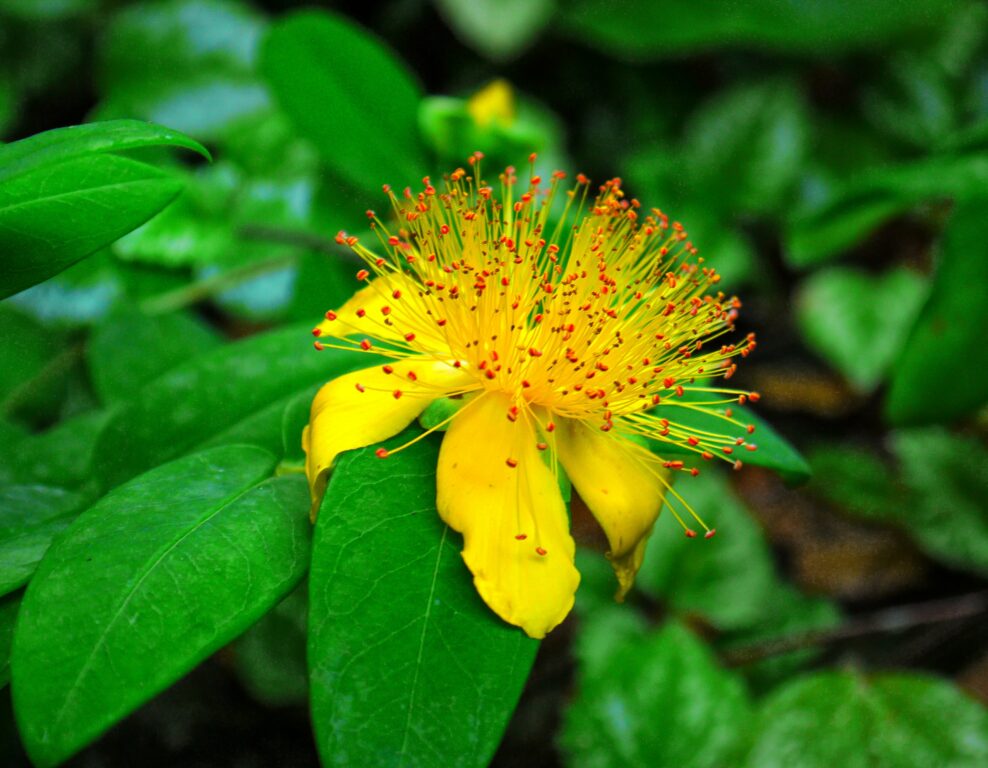
If you’re looking for a showy and low-growing ornamental you’ll love the Rose of Sharon. Rose of Sharon is a shade lover and grows relatively fast even in shade.
Rose of Sharon is considered invasive in a few select states but not many at current. Check with your local council to confirm before deciding to choose this as a ground cover.
- Height: 12-18 inches
- Range: Asia
- Climate: Zones 5-10
- Functions: Used as an ornamental semi-evergreen ground cover. Prevents erosion, is gorgeous when cascading, and attracts butterflies.
- Light requirements: Deep, full, semi, or no shade.
- Soil preferences: Moist or dry soil and drought tolerant. Suitable for heavy clay.
Consider an alternative if invasive in your area, please check before committing.
Nature Hill’s Nursery offers two types of Rose of Sharon (and calls them St. Johns Wort). If you prefer to grow from seed, plenty of options with free shipping are available here.
Mottled Wild Ginger (Asarum shuttleworthii)
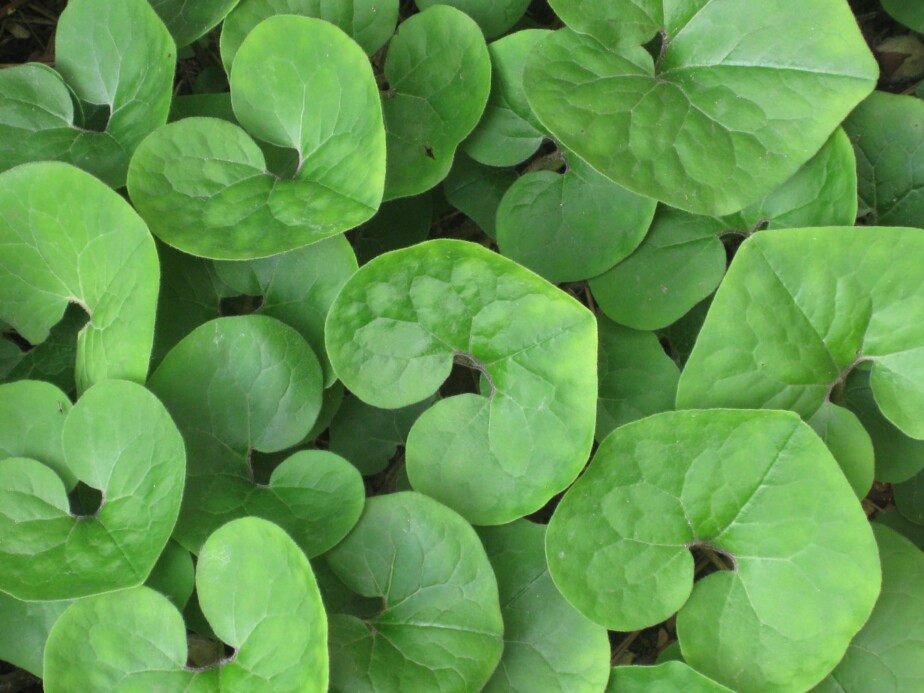
If you’re all about the ginger (and sticking to native species), this variety is native to North America and also thrives in the fullest of shades.
With ideal conditions, wild gingers grow quite fast. So if you’re space offers moist soil and protection from the scorching sun—this may be a good and useful choice.
- Height: 4 inches
- Range: Native to North America
- Climate: Zones 5-9
- Functions: Fragrance, rock gardens, and edible polycultures.
- Light requirements: Full shade or partial shade.
- Soil preferences: Moist soil and good drainage. Suitable for heavy clay.
You’ll find wild ginger available by seed or root here.
British Columbia wildginger (Asarum caudatum)
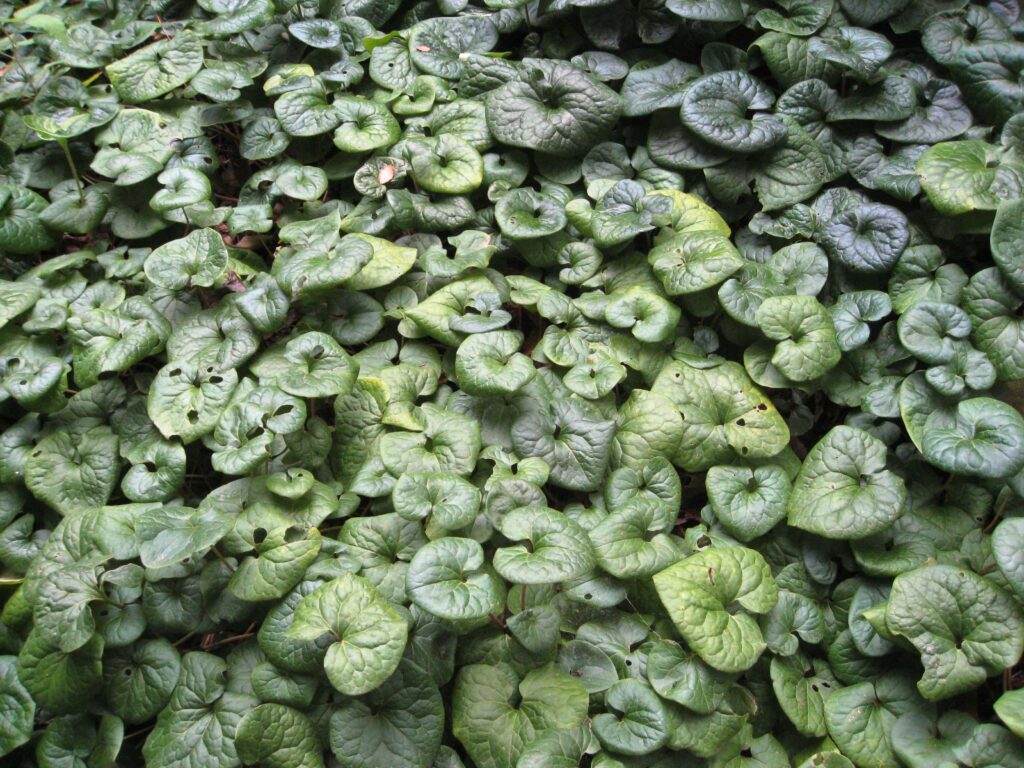
Wild ginger comes in a lot of varieties. In general, they are most useful for covering ground in deep shade. Wild ginger of all types tends to grow lush in the deepest of shades or light to partial shade.
Most wild gingers grow slow to moderate in pace, but with the right conditions, they are very fast growers! Moist soil and protection from the direct sun will enable these cuties to flourish.
It’s best to choose a ginger that grows native in your area. You’ll find the other type of wild ginger as you continue to the zone 5, 4, and 3 ground cover lists. The end of this post has a link to the zone 5 post, and the zone 5 post has a link to zone 4, and then 3. So keep scrolling to follow the path and uncover all your choices!
- Height: 8 inches
- Range: Native to Western North America
- Climate: Zones 6-10
- Functions: Edible and potentially medicinal roots used for tea. Used as a ‘scent confuser’ in food forests. Or as an ornamental ground cover for its shapely dense foliage.
- Light requirements: Full or semi-shade.
- Soil preferences: Moist soil.
Ferriseeds offers seeds here.
Greater Celandine (Chelidonium majus)

Greater celandine is considered a non-native invasive to North America. Celandine Poppy (Stylophorum diphyllum) is a similar-looking but native North American ground cover but has a slow growth rate.
This unique (and historically medicinal) ground cover is soft to the touch yet textural to the eyes. If you need your ground covered in no time, greater celandine will green up your space quickly—but if you’re in North America, this may not be the best choice.
- Height: 14-22 inches
- Range: Native to North America, Europe, and Asia
- Climate: Zones 5-8
- Functions: Fast-growing ground cover for shade with attractive yellow flowers. Commonly used in pollinator, food forest, or woodland gardens.
- Light requirements: Full, partial, or no shade.
- Soil preferences: Moist and adaptable to various soil types. Suitable for heavy clay.
Seeds are available here.
Chameleon Plant (Houttuynia cordata)

The chameleon plant is known for fast growth and is lesser known as highly invasive in some areas, but is primarily aggressive only in ‘perfect’ boggy conditions. See what locals say about this plant in your area before making this your ground cover choice.
If you have a shaded area with too much moisture, wet soil, or even a little pool of water where nothing seems to grow, the chameleon plant may be a choice that works—unless it is considered highly invasive in your area, please check first.
If the rest of your soil is dry and you have one spot with a lot of water or pooling, you may be able to control this edible plant easily. This plant requires these conditions under partial shade and it can also grow in full shade.
- Height: 10-14 inches
- Range: Native to Asia
- Climate: Zones 5-10
- Functions: Beauty. Borders. Massing. Edible. Fast ground coverage. June blooms. Unique flavoring.
- Light requirements: deep shade or partial shade.
- Soil preferences: Moist to wet soil or water.
Otherwise known as ‘fish-smelling herb’ (I know it sounded good, until now) and seeds can be found here.
Hydrangea (Hydrangea anomala)
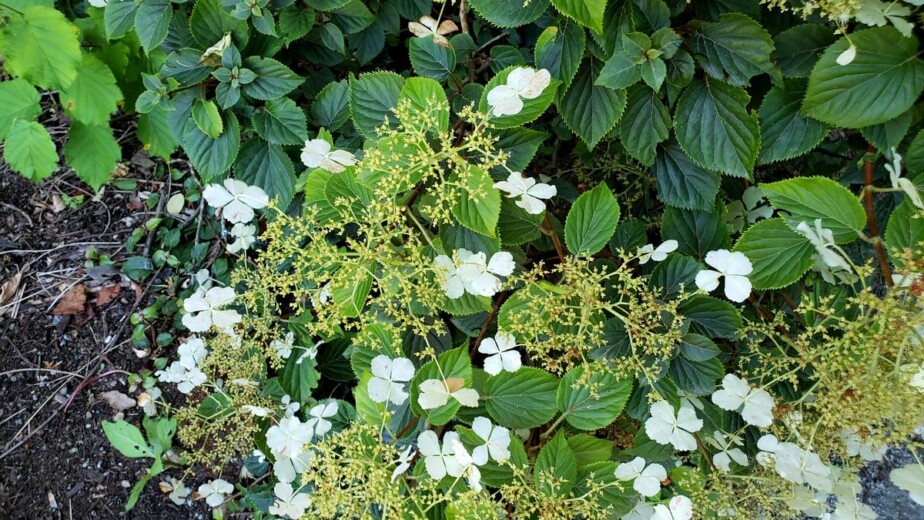
This hydrangea (anomala) is a fast-growing deciduous perennial that spreads of climbs up to 40 feet in length. It grows in full shade, partial shade, or with no shade—as long as its roots stay moist.
While native to Asia, hydrangeas are grown all over because it is favorably ornamental. Most North American areas consider this aggressive by nature but not necessarily invasive to natives.
- Height: 3-4 inches
- Range: Asia
- Climate: Zones 4-8
- Functions: Ornamental—the flower color is largely affected by soil acidity and is grown for show. Leaves and sap are sweet and edible.
- Light requirements: Full/deep shade to partial shade.
- Soil preferences: Well-drained moist soils.
Find seeds here. It’s also known as “climbing hydrangea” and is available as plant starts in containers.
Creeping indigo (Indigofera hendecaphylla)

For those in tropical climates, this legume is widely used in food forests, otherwise known as agroforestry. It grows in all sunlight levels and is particularly drought-resistant.
In many areas, however, its been cautioned that this plant has invasive tendencies and may not be a good introduction. It’s been said to take over lawns in the course of a single growing season—hey, you asked for fast-growing ground covers! This is definitely one.
- Height: 12-18 inches
- Range: Africa & Asia
- Climate: Zones 10-12
- Functions: Nitrogen fixer. Soil stabilizer. Ground cover. Green manure. Attracts wildlife.
- Light requirements: Full/deep, partial, or no shade.
- Soil preferences: Dry or moist soil and persists through drought. Grows well in a range of soils from light to heavy.
Creeping indigo may be invasive in non-native areas, do check with your local councils before sourcing the plant.
Sweet Coltsfoot (Petasites frigidus)

Although native, this speedy grower is quite invasive. Any coltsfoot is very vigorous in growth with pretty flowers and lush foliage. Many who choose coltsfoot do so for their medicinal potential.
This ground cover is suitable for wild/woodland gardens. This will take over a manicured garden if upkeep is a thing in your books. Food forests, and wild, or neglected gardens are the best placements for any coltsfoot.
- Height: 4-20 inches
- Range: Native to North America & Europe
- Climate: Zones 6-10
- Functions: Used as a ground cover in food forests for potential medicinal and edible uses.
- Light requirements: Full, semi, or no shade
- Soil preferences: Moist or wet areas with light to heavy soil.
Seeds for this or other varieties may be available here.
Foamflower (Tiarella cordifolia)

Foamflower is known for fast ground coverage, shapely foliage, deer resistance, and neat appearance.
It has a fast-spreading native and is not considered invasive. It shares the space well with other ground covers and natives.
- Height: 12 inches
- Range: Native to Eastern North America
- Climate: Zones 3-9
- Functions: Often used as a ground cover for edging gardens and deer resistance. Popular in rock or woodland gardens.
- Light requirements: Full or partial shade.
- Soil preferences: Light to heavy moist soils.
SeedVilleUSA offers foam flower seeds and Nature Hills Nursery offers 4 types of foamflower plant starts here.
Creeping Bramble (Rubus tricolor)

An evergreen ground cover that produces fruit, even in shade! Creeping bramble thrives best in full or partial shade as it receives protection from intense heat waves.
The foliage stays on all year in warmer climates above zone 7. In zone 6, however, this will likely perform as a semi-evergreen, meaning it will lose its leaves for a short portion of the season.
Although not native to North America, this creeping raspberry isn’t considered invasive. It can begin to ‘take over’ if left unmanaged for years. But if you keep an infrequent eye on its growth it shouldn’t pose any major issues.
- Height: 1 foot
- Range: Native to Asia
- Climate: Zones 6-9
- Functions: Dense and vigorous edible ground cover for food forests or between taller shrubs and trees. Drought resistance.
- Light requirements: Full, semi, or no shade.
- Soil preferences: Moist or moist well-drained soil with light to heavy textures. Drought tolerant when established.
These are available in pots here!
Labrador Violet (Viola labradorica)
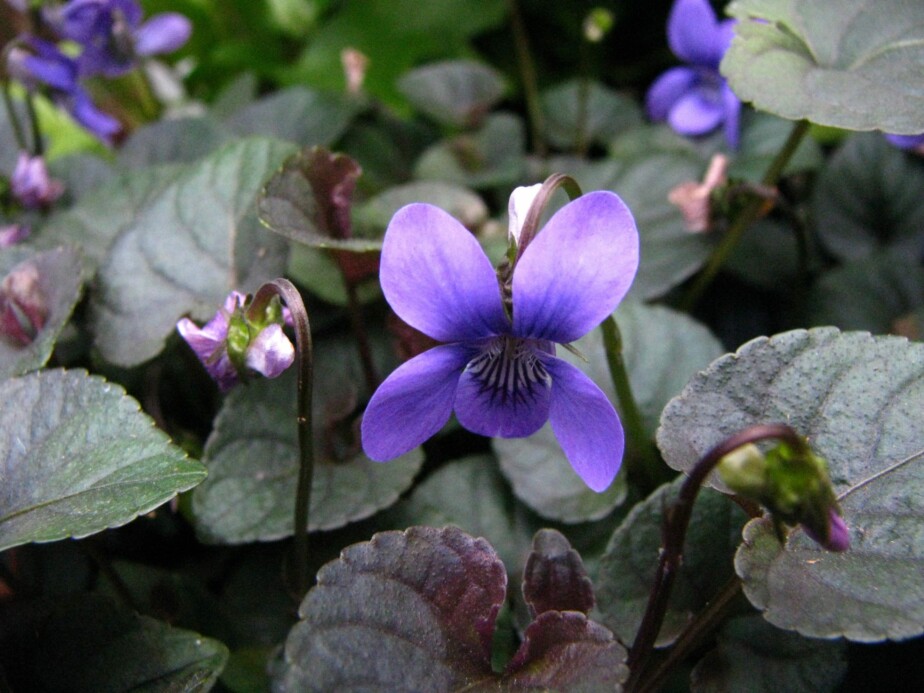
With their contrasting dark foliage, labrador violets are typically used as borders in rock gardens, food forests, or general woodland/wild gardens.
This violet seems to be quite disagreeable in regards to its invasiveness or not. So do gather the opinions of your local gardeners and violet-lovers.
- Height: 3-4 inches.
- Range: Native to North America.
- Climate: Zones 3-8.
- Functions: Ornamental borders. Attracting butterflies. Edible flowers and leaves for salad, cooked greens, or tea.
- Light requirements: Full dense shade to partial shade.
- Soil preferences: Moist
Seeds are available here on Etsy.
Up Next: 12 Shade-loving Ground Covers for Droughts & Low Effort
Recent Posts
There’s no shortage of full-sun ground covers for zone 4 climates! Each plant in this list can withstand the frigid temperatures and also enjoy the hot sun in summer. Full sun means that a plant...
There's no shortage of full sun ground covers, not even in zone 3! Zone 3 climates offer hot but short-lived summers and very cold winters. So each plant in this list can withstand the frigid...
